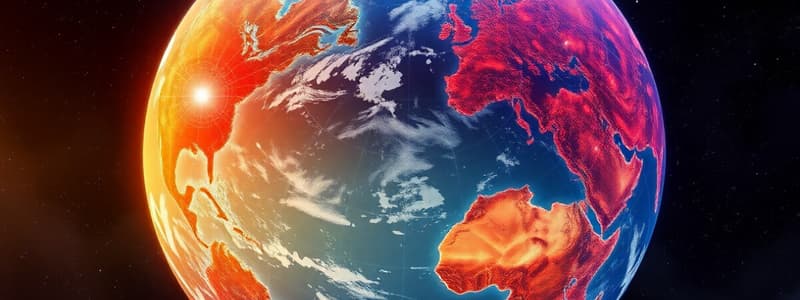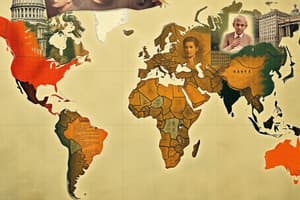Podcast
Questions and Answers
Match each term with its correct definition related to geographical divisions:
Match each term with its correct definition related to geographical divisions:
Northern Hemisphere = The half of Earth north of the equator. Southern Hemisphere = The half of Earth south of the equator. Eastern Hemisphere = The half of Earth east of the Prime Meridian. Western Hemisphere = The half of Earth west of the Prime Meridian.
Match the map features with their representation on Ordnance Survey (OS) maps:
Match the map features with their representation on Ordnance Survey (OS) maps:
Buildings and campsites = Represented by symbols. Roads, paths, rivers, railways = Represented by different styles of lines. Terrain = Indicated by contour lines. Elevation = Shown by numbers on contour lines.
Match each description with the geographical factor it influences:
Match each description with the geographical factor it influences:
Climate = Influences the types of clothing worn and foods available in a region. Terrain = Affects the steepness of slopes represented by contour lines on a map. Natural Resources = Determines the types of goods a country can produce. Geographical Features = Can present challenges such as regular tropical storms.
Match the contour line patterns with the land features they represent:
Match the contour line patterns with the land features they represent:
Match the aspect of a region to its description:
Match the aspect of a region to its description:
Flashcards
What are hemispheres?
What are hemispheres?
Halves of the Earth divided by the equator (northern and southern) or the Prime Meridian (eastern and western).
What is the Prime Meridian?
What is the Prime Meridian?
An imaginary line of longitude that runs through Greenwich, England, dividing the Earth into eastern and western hemispheres.
What is Terrain?
What is Terrain?
The physical characteristics of the land, including elevation, slope, and features.
What are OS Maps?
What are OS Maps?
Signup and view all the flashcards
What are Contour Lines?
What are Contour Lines?
Signup and view all the flashcards
Study Notes
Global Areas
- Geography uses specific terms to describe locations.
- The Earth is primarily divided into hemispheres.
- The equator divides the Earth into the northern and southern hemispheres.
- The Prime Meridian splits the Earth into the western and eastern hemispheres, and runs through Greenwich, England.
- Regions are areas that share similar physical and human geography characteristics.
- The physical geography of an area often influences its human geography.
- Factors such as resource availability, climate, and terrain determine the suitability of an area for human habitation.
- Similar climate and terrain across lands result in similar natural vegetation and agricultural suitability.
- Cultural characteristics within a region are based on available foods and climate-appropriate clothing.
- Shared ideas and principles guide the behavior and values of people within a region.
- Regional cultures exist despite different languages and cultures across individual countries.
- Countries within a geographical region face similar challenges.
- Challenges can arise from climate or weather patterns, such as tropical storms or droughts.
- Similar geographical and geological conditions lead to similar natural resources and goods produced.
- Countries within a region may face trade challenges with each other and other countries due to similar resources.
Why Use Maps
- Maps help to figure out how to get from place to place.
- Maps are useful for finding hiking routes, campsites, or driving directions.
- Maps provide information about a place's size, amount of forestation or steepness of hills.
- The Ordnance Survey (OS) is the UK's mapping agency that covers the entire country.
- OS maps use symbols to represent features such as buildings, campsites, car parks, and forests.
- Different line styles on OS maps represent roads, paths, rivers, and railways.
- OS maps use a key to explain the symbols used.
- Terrain information, like hills or valleys, is shown on OS maps.
Contour Lines
- Contour lines are orange lines on OS maps
- Contour lines join points of equal elevation or height
- Contour lines include numbers to show the elevation.
- The closer the contour lines, the steeper the terrain.
- Contour lines help visualize the shape of the land and features like ridges.
- Closer contour lines indicate a steeper slope.
- A "V-shaped" contour pattern decreasing in height indicates a valley.
- A river can indicate a valley.
- Circular contour lines increasing in height indicate a hill
- Far apart contour lines mean the land is flatter.
- Close together contour lines show that the land is steep
Studying That Suits You
Use AI to generate personalized quizzes and flashcards to suit your learning preferences.




